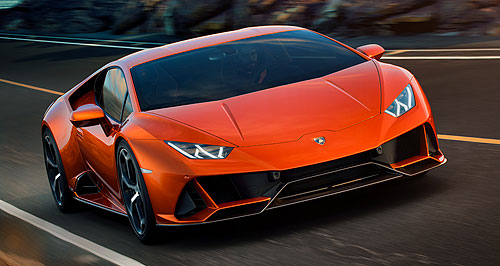LAMBORGHINI has leveled up its Huracan supercar with a mid-lifecycle facelift that ushers in a new Evo moniker, rear-wheel steering and the same 470kW/600Nm 5.2-litre naturally aspirated V10 petrol engine as the Nurburging-conquering Performante.
Rechristened Huracan Evo, the entry-level Lamborghini model now boasts an additional 21kW/40Nm, with peak power available from 8000rpm and maximum torque on tap at 6500rpm from the mid-mounted engine.
Sending drive to all four wheels via a seven-speed dual-clutch automatic transmission, the 1422kg Huracan Evo can accelerate from zero to 100km/h in just 2.9 seconds, 0-200km/h in 9.0s and onto a top speed of more than 325km/h.
For comparison, the outgoing Huracan that was introduced in 2013 needed 3.2s and 9.9s to hit 100km/h and 200km/h respectively from a standstill.
Externally, the Evo is fitted with a revised front bumper, updated wheel designs, new side intakes, bumper-integrated dual exhaust outlets and body-coloured rear diffuser.
Inside, occupants are treated to a new 8.4-inch HMI touchscreen infotainment system with multi-finger gesture controls, Apple CarPlay, satellite navigation, voice commands and an optional dual-camera telemetry system.
Sports seats and a cabin fitted with a mix of Alcantara and leather carry over, while options for body-coloured highlights and carbon-finished touches are also available.
A new orange exterior colour is also available, dubbed Arancio Xanto.
Like the S version did for its Aventador sibling, the Evo introduces rear-wheel steering to the Huracan nameplate, which works in conjunction with the Lamborghini Dynamic Steering (LDS) and torque vectoring systems for better stability at high speeds and improved maneuverability at low speeds.
The Huracan Evo is also fitted with a Lamborghini Dinamica Veicolo Integrata (LDVI), which monitors and controls the supercar’s dynamic behaviour on the fly.
In addition, the Lamborghini Piattaforma Inerziale (LPI) system, which uses a set of accelerators and gyroscopes positioned in the car’s center of gravity, has also been upgraded, improving the vehicle’s reaction time when adjusting the magneto rheological suspension, traction control and torque vectoring settings.
As before, the Huracan Evo features three driving modes – Strada, Sport and Corsa – that can be switched via the Anima controller, progressively dialing up throttle, transmission, suspension and steering settings.
However, new in the Huracan Evo is an Ego mode that lets driver personalise individual settings to their preferred tastes.
While Australian pricing and availability is yet to be confirmed, the Huracan Evo will be available in international markets from the second quarter this year wearing a £165,256 ($A295,869) before on-roads pricetag.
However, expect to see a circa-$450,000 price locally, as the outgoing Huracan LP610-4 costs $428,000 in Australian showrooms.
Lamborghini chairman and chief executive officer Stefano Domenicali said the Huracan Evo continues the brand’s supercar ethos.
“Lamborghini is intent on leading the advance to the highest level of super sportscar technologies and driving emotion,” he said. “This is the essence of the new Huracan Evo.
“It takes the extraordinary abilities of the Huracan Performante and combines state-of-the-art vehicle dynamic control to amplify the everyday Huracan driving experience.
“The Huracan Evo is the very definition of evolution: it is a step ahead, redefining the segment parameters. It is remarkably easy to drive, while delivering the most responsive, sensory and agile driving experience, in every environment.”
Last year saw local Lamborghini sales jump by 9.8 per cent, to 134 units, on the back of the introduction of the Urus SUV.
Combined sales of the Huracan and Aventador hit 112 units, an 8.2 per cent drop over 2017’s year-end figures, for fourth place in the over $200,000 sportscar segment behind the Porsche 911 (511), Ferrari stable (241), Mercedes-AMG GT (172) and Aston Martin coupe/convertible line-up (161).





 Alfa Romeo
Alfa Romeo Abarth
Abarth Audi
Audi Aston Martin
Aston Martin BMW
BMW Bentley
Bentley Chrysler
Chrysler Chevrolet
Chevrolet Dodge
Dodge Citroen
Citroen Ferrari
Ferrari DS
DS Ford
Ford Fiat
Fiat FPV
FPV Foton
Foton Haval
Haval Great Wall
Great Wall Honda
Honda Holden
Holden Hyundai
Hyundai HSV
HSV Isuzu
Isuzu Infiniti
Infiniti Jaguar
Jaguar Iveco
Iveco Kia
Kia Jeep
Jeep Land Rover
Land Rover Lamborghini
Lamborghini Maserati
Maserati Lexus
Lexus McLaren
McLaren Mazda
Mazda Mercedes-Benz
Mercedes-Benz Mitsubishi
Mitsubishi Mini
Mini Opel
Opel Nissan
Nissan Porsche
Porsche Peugeot
Peugeot Ram
Ram Proton
Proton Rolls-Royce
Rolls-Royce Renault
Renault Skoda
Skoda Saab
Saab SsangYong
SsangYong Smart
Smart Suzuki
Suzuki Subaru
Subaru Toyota
Toyota Tesla
Tesla Volvo
Volvo Alfa Romeo
Alfa Romeo Abarth
Abarth Audi
Audi Aston Martin
Aston Martin BMW
BMW Bentley
Bentley Chrysler
Chrysler Chevrolet
Chevrolet Dodge
Dodge Citroen
Citroen Ferrari
Ferrari DS
DS Ford
Ford Fiat
Fiat FPV
FPV Foton
Foton Haval
Haval Great Wall
Great Wall Honda
Honda Holden
Holden Hyundai
Hyundai HSV
HSV Isuzu
Isuzu Infiniti
Infiniti Jaguar
Jaguar Iveco
Iveco Kia
Kia Jeep
Jeep Land Rover
Land Rover Lamborghini
Lamborghini Maserati
Maserati Lexus
Lexus McLaren
McLaren Mazda
Mazda Mercedes-Benz
Mercedes-Benz Mitsubishi
Mitsubishi Mini
Mini Opel
Opel Nissan
Nissan Porsche
Porsche Peugeot
Peugeot Ram
Ram Proton
Proton Rolls-Royce
Rolls-Royce Renault
Renault Skoda
Skoda Saab
Saab SsangYong
SsangYong Smart
Smart Suzuki
Suzuki Subaru
Subaru Toyota
Toyota Tesla
Tesla Volvo
Volvo














Facebook Twitter Instagram